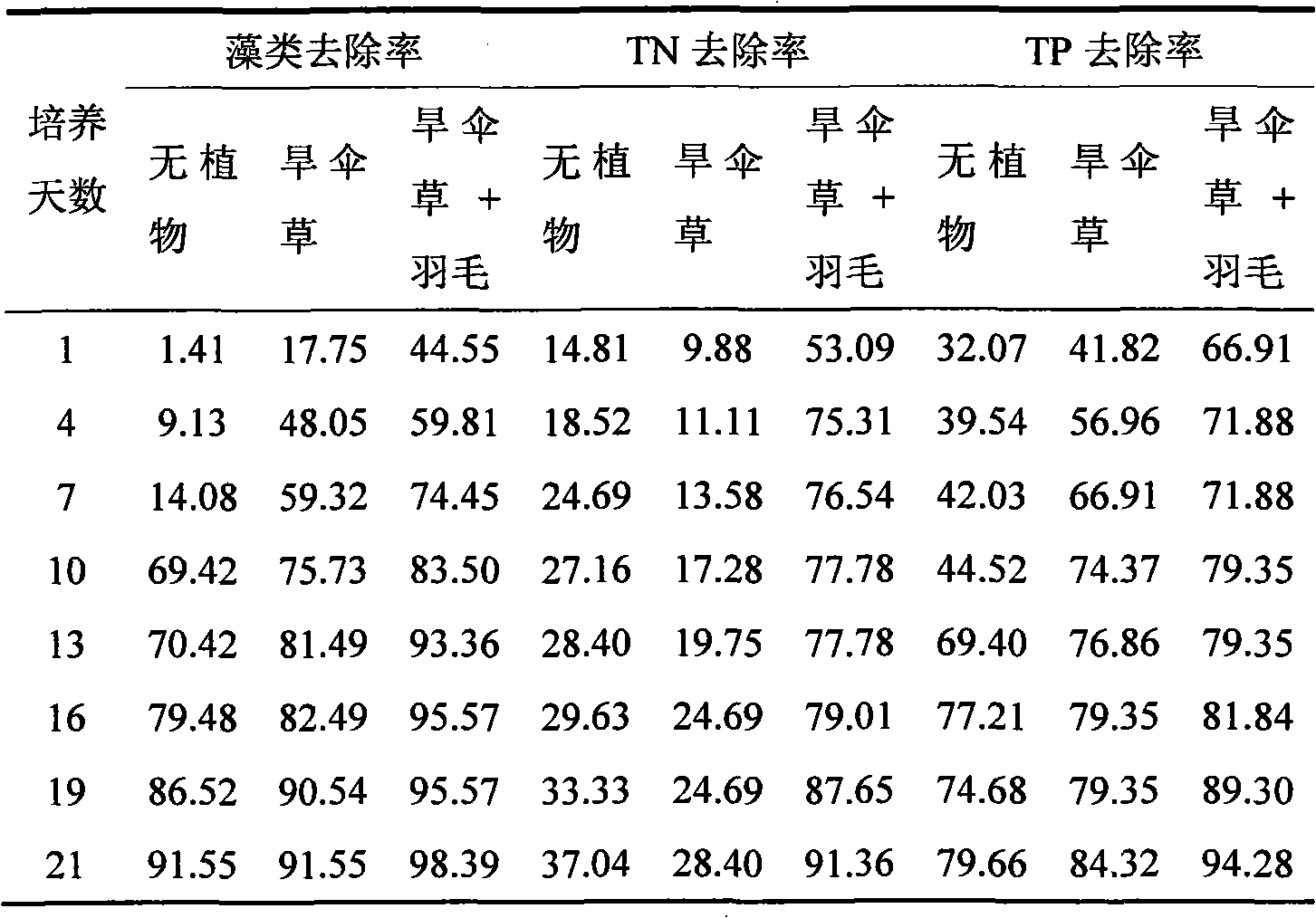Method for controlling growth of scenic water algae by using emergent and submerged aquatic plants
A technology for submerged plants and water bodies, which is applied in the fields of chemical instruments and methods, biological water/sewage treatment, water/sludge/sewage treatment, etc., and can solve the problem of loss of landscape water bodies, rising operating costs, blackening and smelly and other issues, to achieve the effect of low processing cost, avoiding ecological risks, and easy harvesting
- Summary
- Abstract
- Description
- Claims
- Application Information
AI Technical Summary
Problems solved by technology
Method used
Image
Examples
Embodiment 1
[0017] Example 1: Planting test of an artificial lake in a science and technology park in Shenzhen
[0018] A science and technology park in Shenzhen will be located in an artificial lake built by beautifying the pond in the park, with a water surface area of about 150m 2 , with an average water depth of 60cm. Due to the high annual average temperature and abundant sunshine in Shenzhen, the eutrophication of the water body is serious, the algae multiply rapidly, and the algae cell density is relatively high. The checkerboard compound planting method is adopted and implemented through floating beds. Each floating bed is composed of a bottom plate and four baffles. Both the bottom plate and the baffles are made of foamed PVC plastic boards. 10cm, evenly distributed round holes on the bottom plate, the diameter of the round holes is 10cm, and the hole spacing is 20cm. Insert the dry umbrella grass and green feather grass with the roots wrapped in sponges in the round holes, and...
Embodiment 2
[0023] Embodiment 2: Planting test in a small pond in a residential area.
[0024] A small pond in a residential area, the water depth is less than 50cm, and the water surface area is about 30m 2 , pea-shaped, stagnant pond, the bottom is muddy, change the water once a week. Before planting, the water body is dark green, which is a typical eutrophic water body feature, and the water body is directly planted with Xanthograss - Feathergrass. The method adopted is to directly plant the dry umbrella grass and the green feather grass planted in the checkerboard compound planting mode in the bottom mud, the spacing of the green feather grass is 5cm, and then the three green feather grass and the green feather grass are separated by three plants of the dry umbrella grass and the green feather grass. Grass compound planting, that is, the spacing of the dry umbrella grass is 20cm, the thickness of the cultivation layer is 10cm, and the compound planting area is 30% of the water body a...
Embodiment 3
[0029] Example 3: The planting test of the landscape pond in the sunlight greenhouse of a resort.
[0030] The perennial temperature in the sunshine greenhouse of a resort is above 20°C. There are rockery and waterfalls inside. The water flow of the waterfall is small and falls into the lower landscape pond. The water surface of the landscape pond is about 50m 2 , the depth is 0.45m, and the bottom of the pond is artificially laid cement mortar hard bottom. Because there is no water exchange with the outside, and the temperature is high, the sun is shining all the year round, the water body is yellow-green, the turbidity is high, the water body is turbid, and the transparency is poor. The checkerboard compound planting method is adopted. The specific implementation method is: on the hard bottom, use gravel or sand with a particle size of 3 mm to 5 mm to lay a cultivation layer with a thickness of 10 cm. Plant in the cultivation layer, that is, first green feather grass is pla...
PUM
| Property | Measurement | Unit |
|---|---|---|
| Particle size | aaaaa | aaaaa |
| Particle size | aaaaa | aaaaa |
| Thickness | aaaaa | aaaaa |
Abstract
Description
Claims
Application Information
 Login to View More
Login to View More - R&D
- Intellectual Property
- Life Sciences
- Materials
- Tech Scout
- Unparalleled Data Quality
- Higher Quality Content
- 60% Fewer Hallucinations
Browse by: Latest US Patents, China's latest patents, Technical Efficacy Thesaurus, Application Domain, Technology Topic, Popular Technical Reports.
© 2025 PatSnap. All rights reserved.Legal|Privacy policy|Modern Slavery Act Transparency Statement|Sitemap|About US| Contact US: help@patsnap.com



